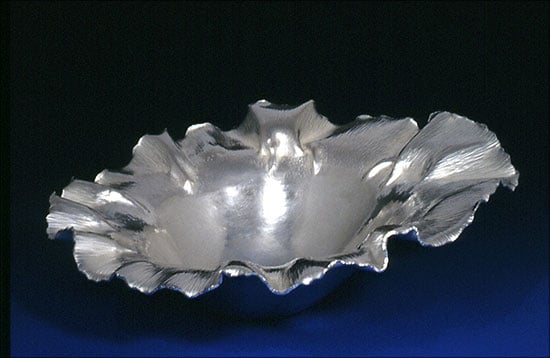Materials: Argentium Sterling Silver
Dimensions: 4" x 10" x 10"
Silver bowl
Partially formed by deep drawing with a hydraulic press. Finished with traditional silversmith hammers and techniques.
Photo credit: Cynthia Eid
Cynthia Eid
Lexington, MA. USA
The paradox that a “soft”, fluid-looking metal form has evolved from flat, stiff rectangles though my force, determination, and tenacity fascinates me. I am entranced by the metal’s progressive mutations — through hammering, persuasion, and struggle — from a lifeless plane of metal toward an object of vibrancy, unity and fluidity.
The forms of the objects I make have their roots in my gardens, and my meanderings through the woods and along the water’s edge. It is difficult for me to take a walk without lining my pockets with rocks, shells, leaves, and twigs. These souvenirs fill the windowsills of my studio. The allusions to nature are intentionally ambiguous, to encourage interactive response and contemplation by the viewer. The similarities to nature occur through my subconscious sense of beauty and methods of moving metal, rather than through conscious study or design. Experimentation, a sense of play, and serendipity play large roles in the designs of my work.
These containers and vessels definitely hold their place in the world of stunning art objects as well as in the world of metalsmithing.
Since the dawn of time humans have created containers to hold things that were important to them, from large vessels to hold food and harvests to intimate containers for small precious things. They might hold memories, ashes, medicine, beverage, fruit or food - but all spring from the imagination and skill of the maker. Some have specific religious functions, some are meant for everyday use. When one thinks of a vessel or container the inclination is to think of something with solid walls - yet many of these works involve the exploration of positive and negative space, and the use of negative space to help create the illusion of the wall of the vessel.
As the world’s largest jewelry related internet site, Ganoksin strives to develop exhibitions showcasing work from around the world. This exhibition was open to all metalsmiths, professional and amateur, advanced and beginner. Participants are from The Netherlands, the USA, Canada, Australia, Costa Rica, the United Kingdom, Israel, Hong Kong, Colombia, Romania, Italy, Ireland, Japan, Malaysia and Denmark. While most of the pieces are by an individual metalsmith, some are collaborations, one of three artists spanning 50 years.
In total 319 artists contributed 729 show pieces for the permanent online exhibition.
Objects in the exhibition include boxes, lockets, urns, ash containers, bowls, wine cups, reliquaries, match holders, vases, teapots, pitchers, sugar bowls, baskets, nests, pillboxes, clutches and a range of sculptural forms. A variety of techniques are showcased covering a wide range of metalsmithing techniques. Materials used include everything from gold and silver to less expensive metals. Ornamentation includes the addition of enamel, chasing and repousse’, gemstones and found objects.
The exhibition was curated by Beth Wicker, President of the North Carolina Society of Goldsmiths in the United States, and Adjunct Instructor at Northeastern Technical College in South Carolina. Director of the exhibition is Hanuman Aspler, founder of The Ganoksin Project, the world’s largest internet jewelry site.
